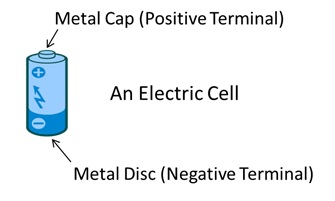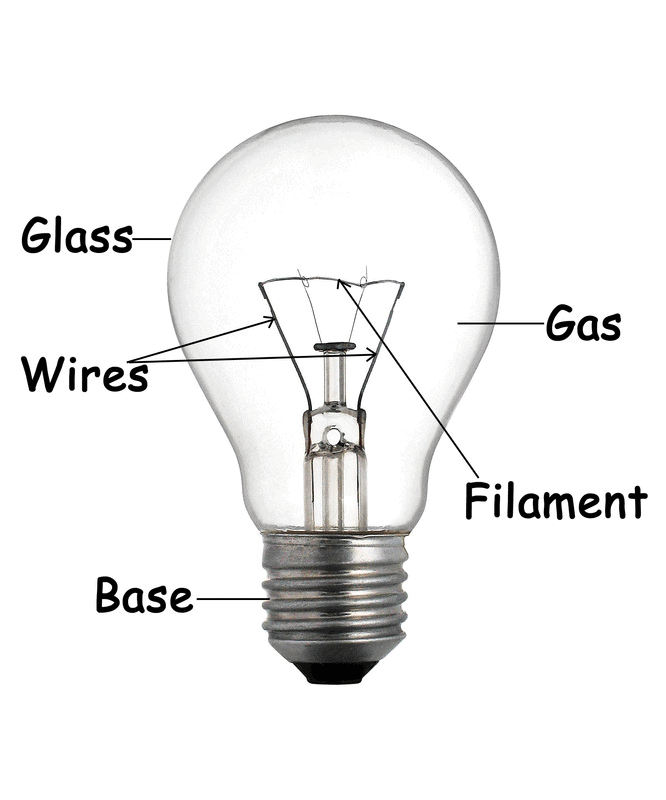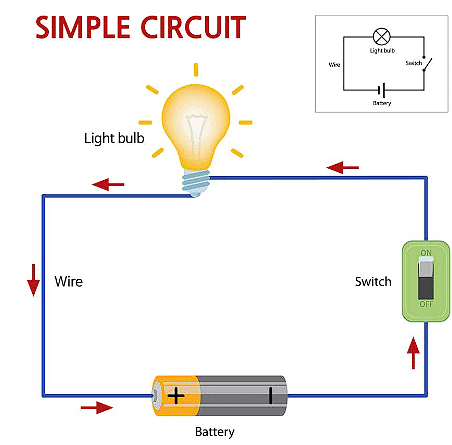Electricity and Circuits Class 6 Notes Science Chapter 9
| Table of contents |

|
| Electric Cell |

|
| A Bulb connected to an Electric Cell |

|
| An Electric Circuit |

|
| Electric Switch |

|
| How does a cell connected in a battery? |

|
| Electric Conductors and Insulators |

|
Electric Cell
A device that is used to generate an electric current through a series of chemical reactions is called the Electric cell.

Bulb
We get light from a thin tiny wire inside the glass cover. This is called a filament. It is supported by two thicker wires, as shown in Fig. One of these thick wires is connected to the metal casing around the base of the bulb. The other is connected to the metal tip of the base. The base of the bulb and the metal tip of the base are the two terminals of the bulb. These two terminals are fixed in such a way that they do not touch each other.
The inside portion of the bulb is filled up with inert gases, like argon.
 Torch Bulb
Torch Bulb
A Bulb connected to an Electric Cell
An electric cell is a device that supplies electrical energy to devices that function using electricity. Thus, an electric cell produces electricity for a torch to glow. In fact, not only a torch, an electric cell provides electricity to a number of devices, such as toys, alarm clocks, pocket radios and cameras.
An electric cell has a cap, just under which there is a plus sign. This is the positive terminal of the cell. At the other end of the cell, there is a flat metal disc with a minus sign just above the disc. This metallic disc is the negative terminal of the cell. These terminals of the cell can be used to connect it to various devices. Inside a cell, there is dark powdery stuff, which is the chemical. This chemical helps the cell to provide electricity to the device it is connected to.
When a cell is connected to a device, the strength of the chemical decreases. Finally, when the entire energy of the chemical is spent, the device connected to the cell stops functioning. A rechargeable cell or a storage battery can be recharged
A torch bulb is made up of spherical glass which is attached to a metallic base. The bulb inside a torch has a filament. This filament is supported by two thick wires at its ends. When the positive and the negative terminals of an electric cell are connected to the two terminals of a bulb, electricity passes through the filament and it starts glowing. The terminals of the bulb are fixed in such a way that they do not touch each other.
The bulbs that we use in our homes all look the same. In recent years, a different type of bulb has become popular - the compact fluorescent lamp, generally referred to as a CFL. It is an energy-saving bulb, which has a longer life than an ordinary bulb.
An Electric Circuit
Electrical CircuitA closed path through which the electric current flows is called an electric circuit. The direction of electric current in an electric circuit is from the positive terminal to the negative terminal.
For example, a bulb glows only when the positive terminal and the negative terminal of an electric cell are connected to the two terminals of the bulb.
If the wires from the bulb are connected to the same terminal (either positive or negative), then the bulb doesn't glow.
Sometimes, the bulb may not glow even though the connections are properly made.
This is because the flow of electricity is incomplete as the filament in the bulb is broken. A broken filament bulb is said to be fused.
Electric Switch
A device that is used to stop the flow of electricity by breaking the circuit is called a switch. An electric switch is a simple device that either breaks the circuit or completes it to stop or start the flow of current.
- When the switch completes the circuit, it is called closed switch.
- When the switch breaks the circuit, it is called open switch.
 Closed Switch
Closed Switch Open Switch
Open Switch
Some common types are:
- Toggle switches, which are used in our houses.
- Push-button switches, which are used in the starter of a water pump.
- Joystick switches, which are used in the remote control unit of a toy car.
How does a cell connected in a battery?
(a) Cells in a Battery: A battery is like a box with smaller boxes inside called cells. Each cell produces electricity on its own.
(b) Connecting Cells: Cells in a battery are connected together to make a bigger source of electricity. They can be connected in a line (series) or side by side (parallel).
(c) Making Electricity: Inside each cell, there are special materials that react together to make electricity.
When you connect the battery to something like a toy or a flashlight, the electricity starts flowing from the battery to the toy.
(d) Flow of Electricity: The electricity flows through wires or circuits, just like water flows through pipes.
It goes from one end of the battery, through the wires or circuits, and then back to the other end of the battery.

Electric Conductors and Insulators
All materials do not allow electricity to pass through them. Materials that allow electricity to pass through them are called conductors. Conductors conduct electric current. Since metals are good conductors of electricity, electric wires are made of metals. These electric wires act as conducting materials. So they are used to make electrical circuits. Some common conductors that conduct electric current are copper, silver, gold and aluminium. Copper is the most popular material used for wires. Sometimes we receive electric shocks because our bodies are also good conductors of electricity.
Materials that do not allow electricity to pass through them are called insulators. Insulators oppose electric current and so they are used as protection from the dangerous effects of electricity. Some common insulators are glass, air, plastic, cotton, thermocol, wood and rubber. Water is a good conductor of electricity, but in its purest form, called distilled water, it acts as an insulator. Distilled water is, therefore, used in batteries as an insulator. We use various electrical appliances every day. Without the help of insulators, the use of electrical appliances is impossible. The parts of the electric appliances that we touch are covered with insulating material. Example: Plugs and switches are covered with an insulating material such as plastic, and the wire attached to the plug is a metal wire, which is a conductor. So conductors and insulators work hand in hand.
|
70 videos|150 docs|104 tests
|
FAQs on Electricity and Circuits Class 6 Notes Science Chapter 9
| 1. What is an electric cell and how does it work? |  |
| 2. How do you connect a bulb to an electric cell? |  |
| 3. What is an electric circuit and what are its components? |  |
| 4. What are electric conductors and insulators? |  |
| 5. How does a cell connect in a battery? |  |
















